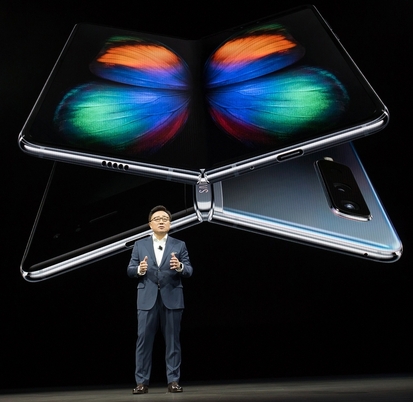 |
|
Koh Dong-jin, president and CEO of Samsung Electronics, at the Samsung Galaxy Unpacked event in San Francisco in February. (provided by Samsung Electronics)
|
Industry observers say electronics giant focused more on launch timing rather than quality
The defects with Galaxy Fold devices have taken two main forms: screen cracking and foreign matter appearing in the hinges. While some of the cases have involved problems occurring after the screen’s protective film was removed, others have involved the display fracturing or going black without any removal of the film. “Based on our testing, we discovered tiny cracks at the top and bottom of the hinge that make it vulnerable to shocks,” a Samsung Electronics official said. “We’re looking at different ways of reducing the cracks,” the official added. The same official also said, “In situations involving cases where foreign matter was found inside the hinge, we do not think it was introduced from outside.” “We’re going to need to look more closely at how this foreign matter appeared,” the official said. The Galaxy Fold’s durability had been the subject of questions for months before the product’s release. Photographs and videos released by Samsung Electronics prompted many internet community users to speculate about the possibility of dust appearing in the crack below the hinge or worry about damage when hard substances became wedged in a loosened hinge. Indeed, a reporter for the US IT network The Verge who received a tester device cited bulging at the product’s center as a result of foreign matter in the hinge as a basis for concluding the item had a defect. Screen quality has been another issue. While other smartphones typically have reinforced glass, Samsung Electronics used colorless polyimide (CPI) film for the Galaxy Fold. The material allows the shape to be bent freely but is less resistant to cracking and shocks than glass; as a plastic, it also has weaker adhesive properties. In contrast, smartphone competitor Apple has been investing since 2017 in the development of ultra-thin glass (UTG), which has been described as “bendable glass.” Industry observers said Samsung may have moved too quickly to launch the product in a bid for the “world’s first” title. Had it been launched as scheduled on Apr. 26, the Galaxy Fold would have been the first foldable smartphone available to consumers. Observers suggested Samsung may have released the product in a less-than-perfect state due to its rivalry with China’s Huawei and other companies for “first place” honors. The company’s overconfidence in its own testing was also mentioned as an issue. Samsung proudly touted its “extreme testing,” which included folding the devices 200,000 times apiece and placing them in high- and low-temperature environments – yet they ended up proving vulnerable to the kind of foreign matter and shocks that occur in everyday life outside of the factory. “The products were tested right up until their launch, but we had no idea there would be problems like this,” said KH Vtec, which supplied hinges to Samsung Electronics. Competitors are moving quickly to fill the market gap left by Samsung. Huawei plans to launch its Mate X in July, while Royole began pre-sales the same day for its own FlexPai foldable phone. By Shin Da-eun, staff reporter Please direct comments or questions to [english@hani.co.kr]






